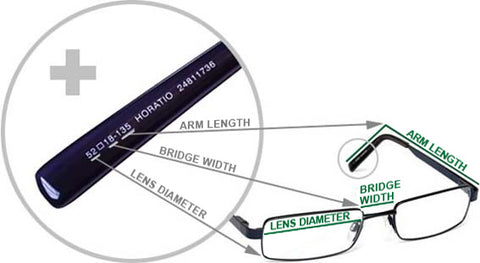*** FREE SHIPPING IN USA ***

DV - Distance vision. Usually part of the prescription designed to improve far vision. For bifocals, this usually the prescription for the top half of the lens.
NV - Near vision. This may represent a single-vision lens prescription to improve near object view, or the reading portion of a bifocal lens. Some prescription forms use ADD in place of NV with a single box to indicate the additional refractive power to be added to the spherical of each eye.
OD - Oculus dexter, Latin for right eye. Sometime prescriptions use RE (right eye), LE (left eye), BE (both eyes).
OS - Oculus sinister, Latin for left eye.
OU - Both eyes.
SPH - SPHERE: The amount of long or short sightedness. This value specifies the optical power of a lens in diopters. It always has a plus (+) or a minus (-) sign in front or above it. The lens power for the distance correction will be minus while the correction for near distance and reading will be plus power. There will always be a value for sphere, even if it is just zero (written as 0.00, Plano or PL). If the vision in one eye is very poor, the word 'balance' or 'bal' may be written.
CYL - CYLINDER: This is the measure for astigmatism. Again, there is always a plus (+) or minus (-) sign present. There may not be a value of cylinder in your prescription.
AXIS - This is a number anywhere between 0 and 180 degrees. It reveals the orientation of the astigmatism. It is not enough to specify how much astigmatism there is; you have to know where the difference in curvature is taking place. If an eyeglass prescription includes cylinder power, it also must include an axis value, which follows the cyl power and is preceded by an "x" when written freehand.
PRISM -This is the amount of prismatic power, measured in prism diopters, prescribed to compensate for eye alignment issues. Only a small percentage of eyeglass prescriptions include prism.
AXIS - This is a number anywhere between 0 and 180 degrees. It reveals the orientation of the astigmatism. It is not enough to specify how much astigmatism there is; you have to know where the difference in curvature is taking place. If an eyeglass prescription includes cylinder power, it also must include an axis value, which follows the cyl power and is preceded by an "x" when written freehand.
PRISM -This is the amount of prismatic power, measured in prism diopters, prescribed to compensate for eye alignment issues. Only a small percentage of eyeglass prescriptions include prism.
BASE - Rotation of the prism that is simply specified as 'base in' (where 'in' means towards the nose)or 'base out' or 'base up' or 'base down'. Only these four positions exist, however, orientations between these four positions can be specified by using combinations of horizontal and vertical prisms in the same lens.
READING PORTION (PROGRESSIVE, BIFOCAL, TRIFOCAL)
ADD, ADD POWER, SEG POWER - For near vision or reading, it is the additional power in the lower portion of a multifocal lens (progressive, bifocal, or trifocal).
SEGMENT HEIGHT (Seg Ht) - The distance from the lowest portion of the lens to the top horizontal line of the Segment or change in power (Your pupil height from the bottom of the frame). There are average segment heights for each frame, but it can be important to have an accurate segment height for your eyes with a particular frame. Depending on the sunglasses, you might need to take the frame to an optician for him to measure the Segment Height for that frame to work properly for your particular face. We recommend that when ordering progressives, you use same or similar frame to get your prescription.

Examples:




